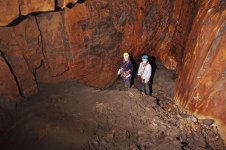Samouse1
Well-known member
An after work trip today found me down Meregill, to have a look at the non existent lake! I know it has been mentioned on here before by a few people but it really is a sight to see.
Dropped down off the fallen tree, which is actually still alive and has leaves and buds currently, I landed next to the usual waterfall. I was immediately greeted by the wonderful smell of death, and looked around for the wooly culprit, it seems almost standard that there's one down there. Down the slope, looking up at the eyeholes above, it really is an impressive bridge across the top! At the far end, another small waterfall comes down from p101b. Here is where the slope meets the far wall and the water sinks into the mud on the true left.

The uninspiring mud pile at the bottom of the Mere.
This is also where @Speleodroid has/had a dig, from which the sound of falling water could definitely be heard. More info here: https://ukcaving.com/board/index.php?threads/meregill-hole-minor-extension.24943/

Looking into the dig, where the rop is the rift drops away down to the right.
My main reason for going was to get a survey of the area where the Mere sits, so I set about doing that, but not before I went down into the very bottom of the slope, where it turned out the mud wasn't quite as firm as it looked. Both feet fully suctioned in, I stood there for a while contemplating how embarrassing a call out it would be, and that I'd never live it down. Eventually I freed my feet, miraculously still in their wellies, and set about shooting a laser pointer about the place.
If I hadn't been preoccupied with the survey, I'd have taken more photos! Alas, you'll all have to go yourselves after a spell of dry weather. The preliminary survey data shows that the bottom of the mere is approx 25m below the "overflow" into Meregill proper. The mere is about 40m long and between 5 and 10 metres wide. The slope is about 30-35 degrees, so I'll let someone else do the maths on how much water roughly there is when it's full!
I'm unsure if the horrible mud I encountered at the bottom there is the same as Cotters Pool I've read about. I think whispering this at the end will summon Pitlamp to enlighten me!
Dropped down off the fallen tree, which is actually still alive and has leaves and buds currently, I landed next to the usual waterfall. I was immediately greeted by the wonderful smell of death, and looked around for the wooly culprit, it seems almost standard that there's one down there. Down the slope, looking up at the eyeholes above, it really is an impressive bridge across the top! At the far end, another small waterfall comes down from p101b. Here is where the slope meets the far wall and the water sinks into the mud on the true left.
The uninspiring mud pile at the bottom of the Mere.
This is also where @Speleodroid has/had a dig, from which the sound of falling water could definitely be heard. More info here: https://ukcaving.com/board/index.php?threads/meregill-hole-minor-extension.24943/
Looking into the dig, where the rop is the rift drops away down to the right.
My main reason for going was to get a survey of the area where the Mere sits, so I set about doing that, but not before I went down into the very bottom of the slope, where it turned out the mud wasn't quite as firm as it looked. Both feet fully suctioned in, I stood there for a while contemplating how embarrassing a call out it would be, and that I'd never live it down. Eventually I freed my feet, miraculously still in their wellies, and set about shooting a laser pointer about the place.
If I hadn't been preoccupied with the survey, I'd have taken more photos! Alas, you'll all have to go yourselves after a spell of dry weather. The preliminary survey data shows that the bottom of the mere is approx 25m below the "overflow" into Meregill proper. The mere is about 40m long and between 5 and 10 metres wide. The slope is about 30-35 degrees, so I'll let someone else do the maths on how much water roughly there is when it's full!
I'm unsure if the horrible mud I encountered at the bottom there is the same as Cotters Pool I've read about. I think whispering this at the end will summon Pitlamp to enlighten me!



